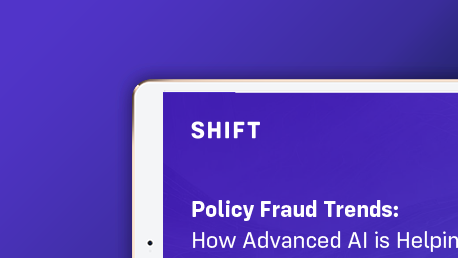AI in Underwriting Risk Detection and its Impact on the Combined Ratio
The second in a series of commentaries on the combined ratio problem facing the insurance industry
Executive Summary
- The insurance industry faces an average revenue loss of between 10 - 15% through premium leakage alone
- Mitigating fraud during the underwriting process can result in shaving up to five points from the combined ratio
- Digital fraud aimed at insurers has increased by between 135-160% in 2023
- Claims severity for individual claims is up to three times higher when evidence of fraud is present; this figure increases to nearly 10 times higher when the suspicion is associated with a fraud network
- Mitigating underwriting risk using AI-powered solutions can have a profound impact on the combined ratio
"Whether due to regulatory or competitive conditions - or both - only raising premiums to cover claims losses is not a tenable solution."
It is well known that the insurance industry is facing a combined ratio crisis. For a variety of reasons, most of them out of the control of both insurers and their customers, it is simply more expensive to make policyholders whole following an incident. Further, severe weather incidents and other natural disasters have created an environment where a greater number of claimants are filing higher value claims, exacerbating the situation. Whether due to regulatory or competitive conditions - or both - only raising premiums to cover claims losses is not a tenable solution. I covered these factors in an earlier piece: The Combined Ratio Problem: Closing the Gap Between Claims Costs and Premiums Using AI.
The good news for insurers is that there are options available to significantly improve combined ratios by applying artificial intelligence (AI) to a number of key processes governing the policy and claims lifecycle. For this article I will focus on the role that mitigating underwriting risk can have on the combined ratio and explore the various ways that having an effective underwriting risk strategy in place can improve the bottom line.
Focusing Solely on Premiums is not Sustainable
As we have witnessed, premiums are not keeping up with losses. And while the natural response to this situation is to raise premiums - which the industry has done - it is not a viable long-term strategy. The process required to increase premiums can be arduous and time consuming and may in fact represent additional costs such as employee resources, legal fees, and other expenses that end up being applied to the combined ratio. The industry’s regulatory environment also carries an impact. Take for example the situation carriers faced following the California wildfires in 2017-2018. Although the State of California Division of Insurance allows carriers to file for rate relief up to 6.9% per filing without a hearing, it took nearly two years to secure an increase greater than the 6.9% maximum allowed by the state. As important, it can take up to 12 months following a rate increase for carriers to recognize the benefit.
For those insurers who do elect premium increases to improve combined ratios, they may find themselves at a competitive disadvantage in the near future if their rate increases begin to go against the grain of the market. In this situation, carriers may find top-line revenue negatively impacted by challenges in finding new business and the very real possibility of formerly loyal policyholders leaving in search of a better deal. And when this happens insurers may end up taking on riskier policies and policyholders to make up the lost top-line revenue. All of this begs the question, “what else can insurers do to proactively protect the profitability of their book?”
Despite some significant challenges, insurers can begin attacking the combined ratio problem during the underwriting process without relying on increasing premiums. Truly understanding the various risks associated with a prospective policy or policyholder, and using that knowledge to make the best decisions possible about what to do about them is one of the best ways to mitigate future losses. AI can help you do just that.
Begin with Stopping Premium Leakage
Carriers incur losses of between 10 - 15 percent per year through premium leakage alone. For the most part, this leakage is not the result of criminal masterminds or fraud networks looking to bilk carriers of millions. Rather, it is often associated with regular policyholders looking to save a little money or through honest mistakes made during the application process. But whatever the cause, premium leakage is still costing insurers a significant amount every year.
AI has been shown to be quite effective at identifying potential premium leakage during the application and quoting process. The ability to generate a complete picture of the applicant and their exposures before finalizing the process is critical. AI can be used to quickly confirm that information provided by the applicant matches that of available public records. It can also be useful in determining if hidden exposures exist - for example by uncovering evidence that the applicant is a ride-share or delivery driver, therefore putting them in a different risk category with a different rate schedule.
The Rise of Digital Fraud
At a time when other industries have seen incidents of digital fraud decrease by nearly 15%, the insurance industry is under increasing attack by digital fraudsters. In fact, digital fraud aimed at insurers has climbed by between 130 - 160% over the last several years. Unlike most incidents of premium leakage, digital fraud is being perpetrated with clear criminal intent.
Fraudsters are taking advantage of anonymity, a side effect of the same digital channels that were originally intended to remove friction from the insurance buying process whether direct-to-consumer or via agent or broker. They make it easier to falsify information, hide identities, and enable new schemes such as Ghost Broking, whereby fraudsters leverage digital and social media channels to sell bogus insurance policies to unsuspecting consumers. AI, in turn, makes it easier to detect the signs of digital scammers attempting to use an insurer’s book of business for their own nefarious purposes. For example, AI can help underwriters see recurring use of personally identifiable information (PII) across supposedly unrelated applications which may indicate the presence of a fraud network.
"Our own research has shown that the average loss ratio per detected fraud network is greater than 500%."
Our own research has shown that the average loss ratio per detected fraud network is greater than 500%. Eliminating that threat from an insurer’s book of business has a profound impact on whether or not the company ends up operating in the black or in the red.
Why Stopping Future Fraud is Critically Important
"Claims severity jumps to almost 10 times that of a legitimate claim when an organized fraud network is involved."
It is well understood that insurance fraud is bad for the bottom line. However, in many cases, the fraudulent claim is only the beginning. Through our work with the leading insurers around the world we have consistently seen that claims severity increases by 300% when an element of misrepresentation or fraud is involved. And that number only applies to individual and/or opportunistic fraud. Claims severity jumps to almost 10 times that of a legitimate claim when an organized fraud network is involved.
Underwriting risk detection is all about identifying potential policyholders whose sole intention is to use their policy to commit fraud - whether individual or as part of a network. Knowing who a customer is and whether or not they have a known history of attempting fraud or can be shown to be associated with a recognized fraud network is one of the best ways to prevent future fraud and effectively reduce claim severity.
Conclusion
Insurance is an inherently risky business. The industry is built on the premise that premiums collected will be greater than what must be paid when policyholders inevitably make a claim. Fraudsters, however, are doing everything they can to tip the scales in their favor and enrich themselves to the detriment of legitimate policyholders. AI has given us a powerful tool in the fight against insurance fraud. It allows the very real opportunity to stop fraud before it happens, which is an amazing value proposition when strategizing
ways to improve the combined ratio.
The Combined Ratio Series
This is the first in a series of commentaries on the combined ratio problem facing the insurance industry. For further discussion of this topic and how the application of AI is addressing this challenge throughout the policy lifecycle, continue reading.
All posts in the series
- The Combined Ratio Problem: Closing the Gap Between Claims Costs and Premiums using AI
- Underwriting Risk and its Impact on the Combined Ratio
- AI-Powered Subrogation Detection and its Impact on the Combined Ratio
- Claims Fraud Detection and its Impact on Combined Ratios



